

I’ve been running steam on an unsupported OS (osx 10.13.6) for almost a year and a half now, and the only issue is a banner at the stop claiming that steam will stop working in 0 days.
I don’t remember what if anything I did to make this happen, but I’ve had no trouble buying, downloading, or playing games in that time.







Did they ever open up Civ VI’s code the way they did for IV and V? Prior to VII coming out, they hadn’t left any way for modders to do the kind of deep dive total conversion mods which happened with the older games.